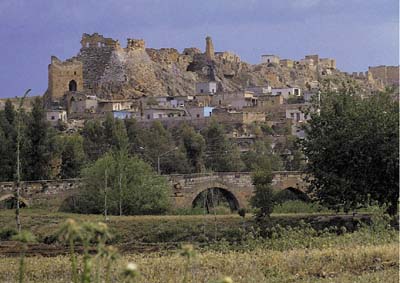
Shayzar (Shaizar) & Syria Ancient Times
6000 BCE to 1516 CE
Saydjari Family Modern Times
1883 to 2011
The Syrian Civil War
Background Facts: Syrian Civil War 2011 to Present:
- Hafez al-Assad and the Alawites sect ruled Syria from 1970-2000.
- Bashar al-Assad (his son) has ruled Syria as president since July 2000.
- As of April 2020, approximately 5.6 million Syrians have fled the country, and an additional 6.2 million people are displaced internally, according to the UN High Commissioner for Refugees.
- When the civil war began in 2011, there were four main factions of fighting groups throughout Syria:
Kurdish forces
ISIS
Other Islamic Groups (Jaish al Fateh, an alliance of the Nusra Front and Ahrar-al-Sham)
Assad regime.
By September of 2020, ISIS was all but destroyed, and the remaining factions had fought to a stalemate with the rebels and the Turkish army on one side and the Syrian army along with their Russian allies on the other side, leaving essentially three factions
Shaizar…A Shell of its Former Glory
The once-proud village of Shaizar, which figured so prominently in the medieval history of the Middle East and the Crusades, now sits quietly under the watchful gaze of the decaying fortress overlooking the Orontes River on the hill above. It is a relatively small village.
Most of its few thousand inhabitants work in agriculture. The historically fertile lands surrounding the village have allowed for a peaceful existence. Each new generation tended the fields, just like their fathers did stretching back to time immemorial; however, the outbreak of civil war in 2011 changed everything.
Shaizar became a town besieged, and the Assad Alawite regime imposed a security cordon around the mostly Sunni community. Before the revolution, the few inhabitants of the Alawite sect lived peacefully with their Sunni neighbors. However, with the outbreak of the revolt in the rest of Syria, old sectarian wounds opened once again and were promoted by the Assad regime as the reason for the revolt.
After the siege of the village of Shaizar by the regime, Assad further tightened the noose on its inhabitants, except for the Al-Midan Alawite neighborhood. The government brought in many pro-Alawite recruits to terrorize the people. Among the more vicious was a man named Abu Sumer, Abu Al-Fahd. They led raids aimed at arresting or driving the young men of Shaizar into compulsory military service. Such roundups also led to massacres.
The regime leveled a large part of the village and used checkpoints to prevent the inhabitants from returning to their farmlands, thus depriving them of their livelihood.
A villager related what he saw to the news media in December of 2017. One day, after the checkpoints eased, and the people of the village could go to their lands. He and several other villagers noticed that the water in irrigation channels was not reaching their farmland. Thinking the canal was blocked by silt or rubbish, they decided to clean the channel with a bulldozer.
Their efforts revealed that the canal was full of bodies. “We were waiting to see some rubbish, but we saw the bodies of our sons, whom we asked about a lot and waited for them, then we learned that (Abu Al-Fahd) slaughtered them and threw them here. We recovered the bodies, and we can hardly believe that these are our sons who were kidnapped.” The man continued, Abu Sumer had been cutting off the heads of the village’s young men, burying the headless bodies in the countryside. The slaughter was indiscriminate regardless of whether the men supported the revolt or not.
These days, the village is desolate, inhabited only by the elderly, as many of its youth were killed, and another part survived by fleeing north.

Jisr al-Shughur
What has become of the city where Mohammed and Badrieh were born?
Along the international highway connecting the city of Aleppo, Syria’s economic capital, with Latakia on the shore of the Mediterranean Sea, the city of Jisr al-Shughur is located in the heart of the embattled Idlib province. The city has a long history of rebellion and independence.
A History of Rebellion & Massacre
The Jisr al-Shughur massacre of 1980 occurred in Syria on March 9, 1980, when helicopter-borne Syrian troops were sent into Jisr al-Shughur to quell demonstrators, who had recently ransacked barracks and Ba’ath party offices in town. A ferocious search and destroy mission ensued that left some two hundred dead, while scores of prisoners were ordered executed in field tribunals. This left a lasting bitterness among the inhabitants of Jisr al Shughur, who had lost relatives in the massacre.
The Syrian Civil War of 2011
Against a background of anti-government protests across Syria, inhabitants of Jisr al-Shughur marched on the local Ba’ath Party headquarters in June of 2011 and set it on fire resulting in violent clashes with the Syrian security forces, including the military. The exact reasons for the fighting, the course of events, and the resulting destruction and deaths are disputed.
The government claimed that it clashed with Islamist-leaning insurgents who had set up an ambush for security forces. Simultaneously, the Syrian opposition described the Jisr al-Shughur clashes as a crackdown against pro-democracy protesters, resulting in a mutiny among soldiers and a large battle with many people being massacred by pro-government forces. The fighting in the city lasted from June 4 – 12 of 2011.
Today, the clashes are seen by many as the beginning of the Syrian Civil War and the first battle of the war. The police were unable to restore order and fled. Some demonstrators seized weapons and ammunition from a nearby army barracks. Later, units of the Syrian Army Special Forces were helicoptered in from Aleppo to regain control. After pounding the town with rockets and mortars, destroying homes and shops, and killing and wounding dozens of people. At least two hundred people were arrested.
On the following day, a military tribunal ordered the execution of more than a hundred detainees. In all, about 150-200 people were said to have been killed.
The control of Jisr al-Shughur by the opposition armed groups was an affront to President Assad, who vowed to regain control at all costs. The city is considered a strategic key to the opposition-held Idlib province, threatening the coastal area and the Russian Khmeimim Air Base. This made it a constant target of air raids from the Syrian & Russian warplanes and helicopters when ground forces failed to wrest control of the city from the Syrian Free Army and their allies.
These air raids have caused the death of thousands of its residents and the displacement of many more while leveling homes and infrastructure. The population of Jisr al-Shughur numbered fifty thousand persons in 2010 before the outbreak of war. Only five thousand civilians remained in the city by the end of the main conflict.
Here is a link to a page containing videos of Jisr al-Shughur
- “Jisr Al-Shughour: The City Which Syrian Regime Wants To Subjugate.” Edited by Enab Baldi, Enab Baldi, 21 July 2019, english.enabbaladi.net/archives/2019/07/jisr-al-shughour-the-city-which-syrian-regime-wants-to-subjugate/.
- Chulov, Martin, and Kareem Shaheen. “Syrian Rebels Hail Fall of Jisr Al-Shughour as Sign of Growing Strength.” The Guardian, Guardian News and Media, 27 Apr. 2015, www.theguardian.com/world/2015/apr/27/syrian-rebels-hail-fall-of-jisr-al-shughour-as-sign-of-growing-strength.